E123 - Evaluating and Implementing ALDI's Business Strategies
VerifiedAdded on 2024/04/25
|24
|5560
|387
Case Study
AI Summary
This case study provides a comprehensive analysis of ALDI's business strategy, examining its mission, vision, objectives, and core competencies in relation to strategic planning. It evaluates the factors considered by ALDI when formulating strategic plans, including future competition trends, customer needs, and competitive advantage. The study assesses the effectiveness of techniques like the BCG matrix and conducts an organizational audit using SWOT analysis to determine ALDI's current strategic position. Furthermore, it includes an environmental audit using PESTEL analysis to understand the macro environment. The case study explores ALDI's strategic choices, such as market penetration and product development, and discusses the implementation of these strategies, focusing on organizational structure, resource allocation, and performance monitoring. The analysis highlights ALDI's strengths in cost leadership and international expansion while also addressing weaknesses like limited marketing and product offerings. The study concludes by summarizing ALDI's strategic challenges and opportunities in the competitive retail industry.
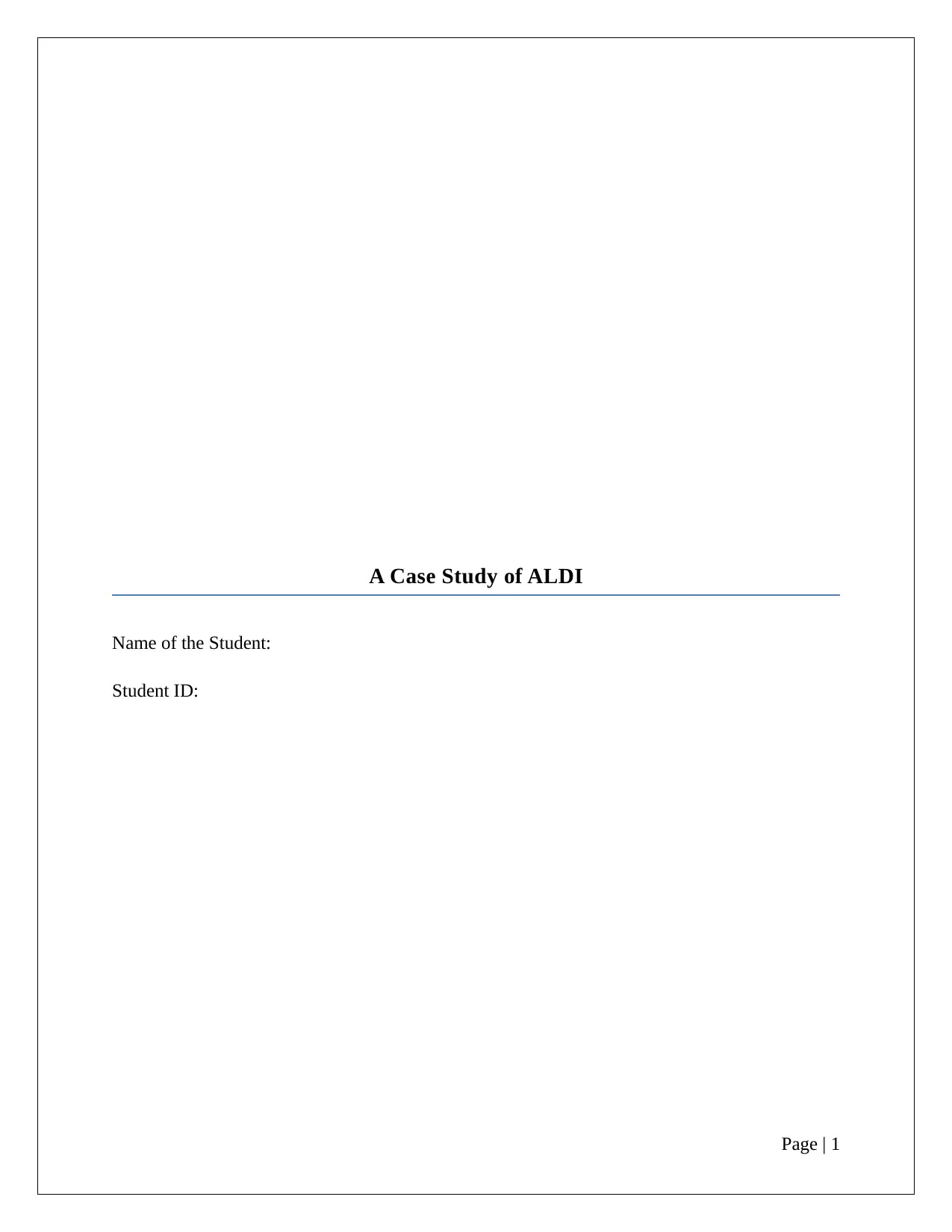
A Case Study of ALDI
Name of the Student:
Student ID:
Page | 1
Name of the Student:
Student ID:
Page | 1
Paraphrase This Document
Need a fresh take? Get an instant paraphrase of this document with our AI Paraphraser
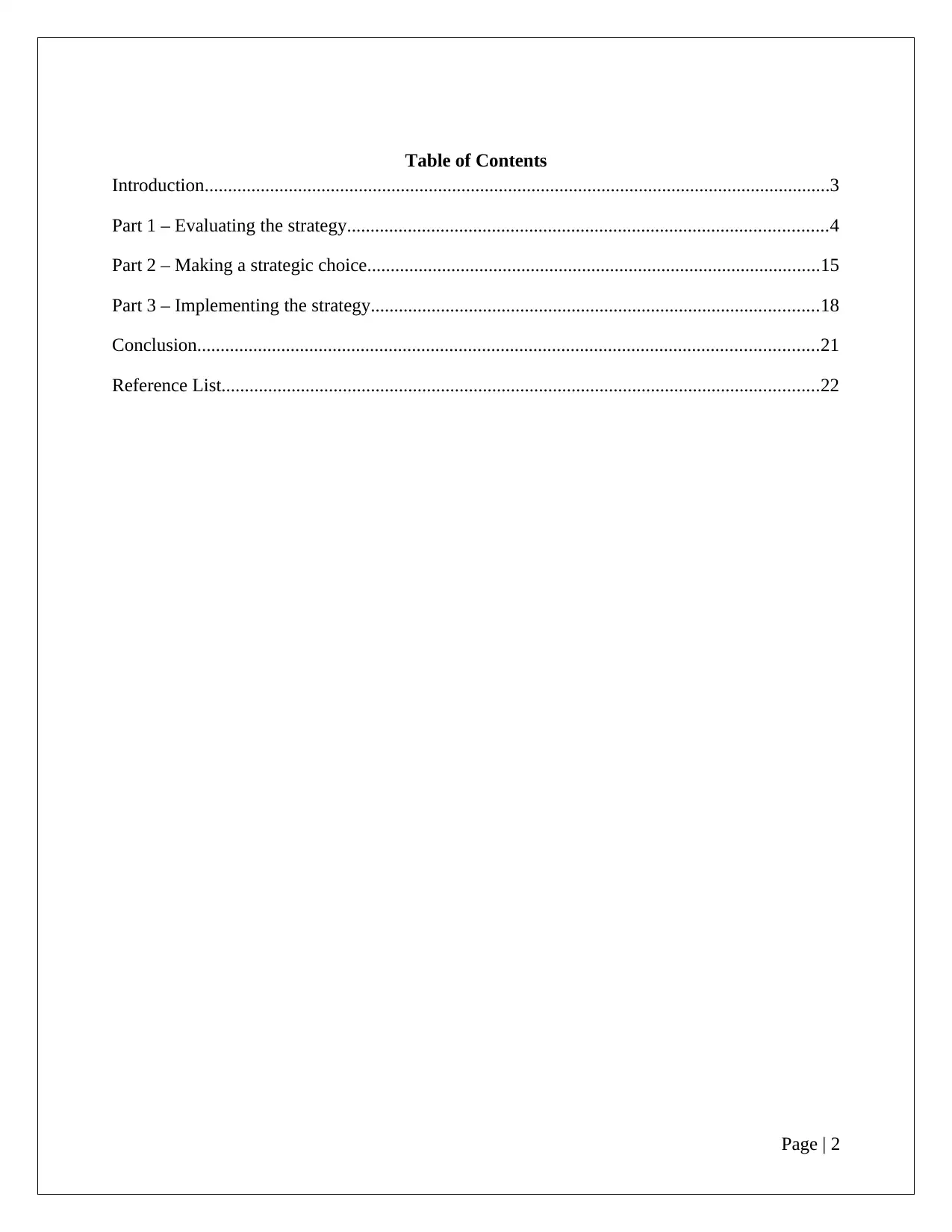
Table of Contents
Introduction......................................................................................................................................3
Part 1 – Evaluating the strategy.......................................................................................................4
Part 2 – Making a strategic choice.................................................................................................15
Part 3 – Implementing the strategy................................................................................................18
Conclusion.....................................................................................................................................21
Reference List................................................................................................................................22
Page | 2
Introduction......................................................................................................................................3
Part 1 – Evaluating the strategy.......................................................................................................4
Part 2 – Making a strategic choice.................................................................................................15
Part 3 – Implementing the strategy................................................................................................18
Conclusion.....................................................................................................................................21
Reference List................................................................................................................................22
Page | 2

Introduction
The increasing competition in the global markets has forced the organizations in all the spheres
of industrial sector to formulate and prepare strategies to combat the competition and threats
posed by the market. The task of strategy formulation assists the companies to intrude into issues
relating to – organizational and environmental audit, stakeholder needs and strategic positioning
of the company in the market. The strategies developed by the companies are in alignment with
the goals and objectives of the organization as it determines the strategies to enter new markets,
ensures optimum utilization of resources and reviews the existing performance. In this
assignment, the significance of developing and implementing the strategies in an organizational
structure have been discussed using several tools and techniques that an organization would use
to prepare strategies.
Company background – Aldi
Incorporated in the year 1946 by two brothers, Theo and Karl Albrecht, Aldi is one of the
leading supermarket chains in the United Kingdom. The success story of Aldi can be cited based
on the 7000 stores established by them in more than 70 countries. The company employs more
than 20000 people in their 500 UK stores (LLP, 2018). The company is credited to be first store
to offer self-service facility to their consumers enhancing the service quality.
Page | 3
The increasing competition in the global markets has forced the organizations in all the spheres
of industrial sector to formulate and prepare strategies to combat the competition and threats
posed by the market. The task of strategy formulation assists the companies to intrude into issues
relating to – organizational and environmental audit, stakeholder needs and strategic positioning
of the company in the market. The strategies developed by the companies are in alignment with
the goals and objectives of the organization as it determines the strategies to enter new markets,
ensures optimum utilization of resources and reviews the existing performance. In this
assignment, the significance of developing and implementing the strategies in an organizational
structure have been discussed using several tools and techniques that an organization would use
to prepare strategies.
Company background – Aldi
Incorporated in the year 1946 by two brothers, Theo and Karl Albrecht, Aldi is one of the
leading supermarket chains in the United Kingdom. The success story of Aldi can be cited based
on the 7000 stores established by them in more than 70 countries. The company employs more
than 20000 people in their 500 UK stores (LLP, 2018). The company is credited to be first store
to offer self-service facility to their consumers enhancing the service quality.
Page | 3
⊘ This is a preview!⊘
Do you want full access?
Subscribe today to unlock all pages.

Trusted by 1+ million students worldwide
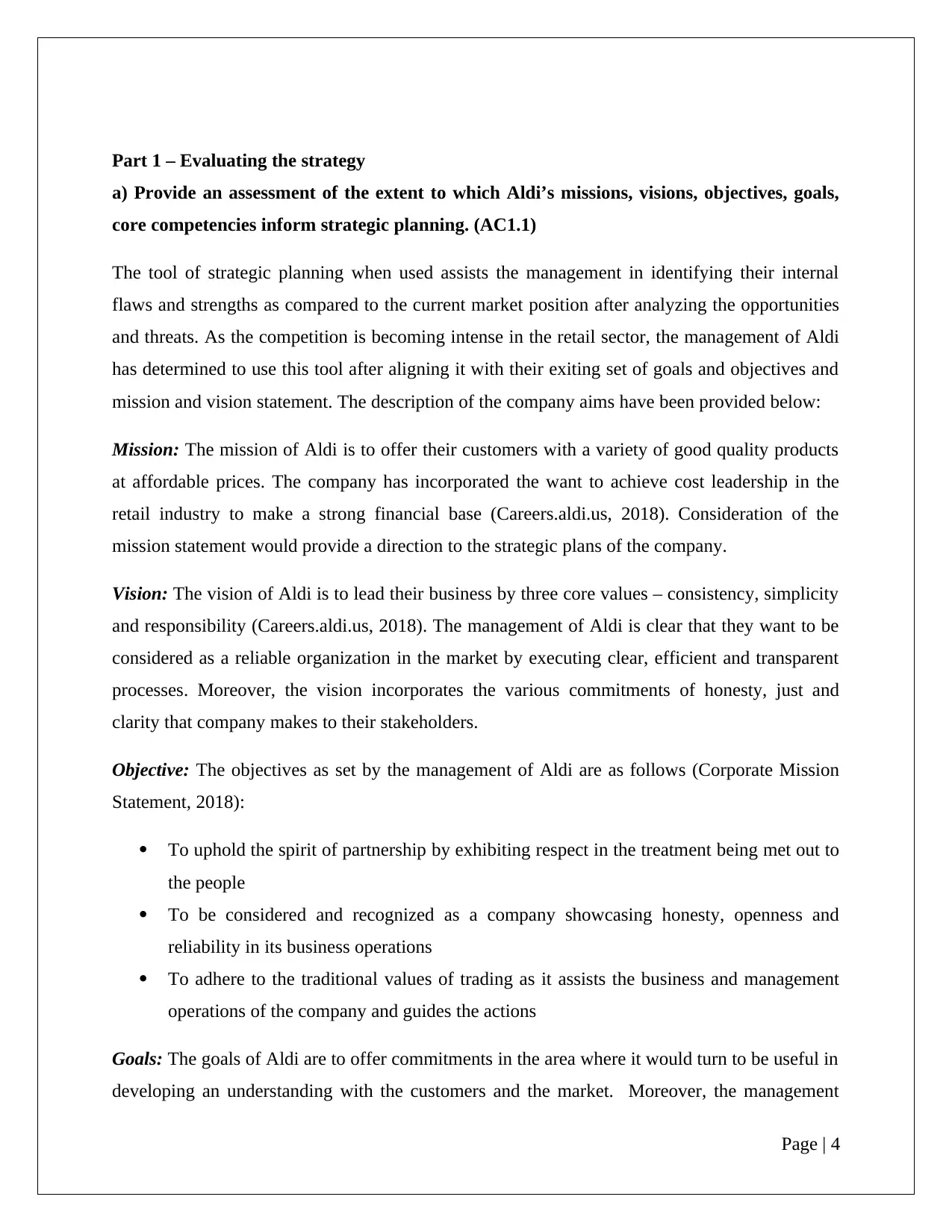
Part 1 – Evaluating the strategy
a) Provide an assessment of the extent to which Aldi’s missions, visions, objectives, goals,
core competencies inform strategic planning. (AC1.1)
The tool of strategic planning when used assists the management in identifying their internal
flaws and strengths as compared to the current market position after analyzing the opportunities
and threats. As the competition is becoming intense in the retail sector, the management of Aldi
has determined to use this tool after aligning it with their exiting set of goals and objectives and
mission and vision statement. The description of the company aims have been provided below:
Mission: The mission of Aldi is to offer their customers with a variety of good quality products
at affordable prices. The company has incorporated the want to achieve cost leadership in the
retail industry to make a strong financial base (Careers.aldi.us, 2018). Consideration of the
mission statement would provide a direction to the strategic plans of the company.
Vision: The vision of Aldi is to lead their business by three core values – consistency, simplicity
and responsibility (Careers.aldi.us, 2018). The management of Aldi is clear that they want to be
considered as a reliable organization in the market by executing clear, efficient and transparent
processes. Moreover, the vision incorporates the various commitments of honesty, just and
clarity that company makes to their stakeholders.
Objective: The objectives as set by the management of Aldi are as follows (Corporate Mission
Statement, 2018):
To uphold the spirit of partnership by exhibiting respect in the treatment being met out to
the people
To be considered and recognized as a company showcasing honesty, openness and
reliability in its business operations
To adhere to the traditional values of trading as it assists the business and management
operations of the company and guides the actions
Goals: The goals of Aldi are to offer commitments in the area where it would turn to be useful in
developing an understanding with the customers and the market. Moreover, the management
Page | 4
a) Provide an assessment of the extent to which Aldi’s missions, visions, objectives, goals,
core competencies inform strategic planning. (AC1.1)
The tool of strategic planning when used assists the management in identifying their internal
flaws and strengths as compared to the current market position after analyzing the opportunities
and threats. As the competition is becoming intense in the retail sector, the management of Aldi
has determined to use this tool after aligning it with their exiting set of goals and objectives and
mission and vision statement. The description of the company aims have been provided below:
Mission: The mission of Aldi is to offer their customers with a variety of good quality products
at affordable prices. The company has incorporated the want to achieve cost leadership in the
retail industry to make a strong financial base (Careers.aldi.us, 2018). Consideration of the
mission statement would provide a direction to the strategic plans of the company.
Vision: The vision of Aldi is to lead their business by three core values – consistency, simplicity
and responsibility (Careers.aldi.us, 2018). The management of Aldi is clear that they want to be
considered as a reliable organization in the market by executing clear, efficient and transparent
processes. Moreover, the vision incorporates the various commitments of honesty, just and
clarity that company makes to their stakeholders.
Objective: The objectives as set by the management of Aldi are as follows (Corporate Mission
Statement, 2018):
To uphold the spirit of partnership by exhibiting respect in the treatment being met out to
the people
To be considered and recognized as a company showcasing honesty, openness and
reliability in its business operations
To adhere to the traditional values of trading as it assists the business and management
operations of the company and guides the actions
Goals: The goals of Aldi are to offer commitments in the area where it would turn to be useful in
developing an understanding with the customers and the market. Moreover, the management
Page | 4
Paraphrase This Document
Need a fresh take? Get an instant paraphrase of this document with our AI Paraphraser
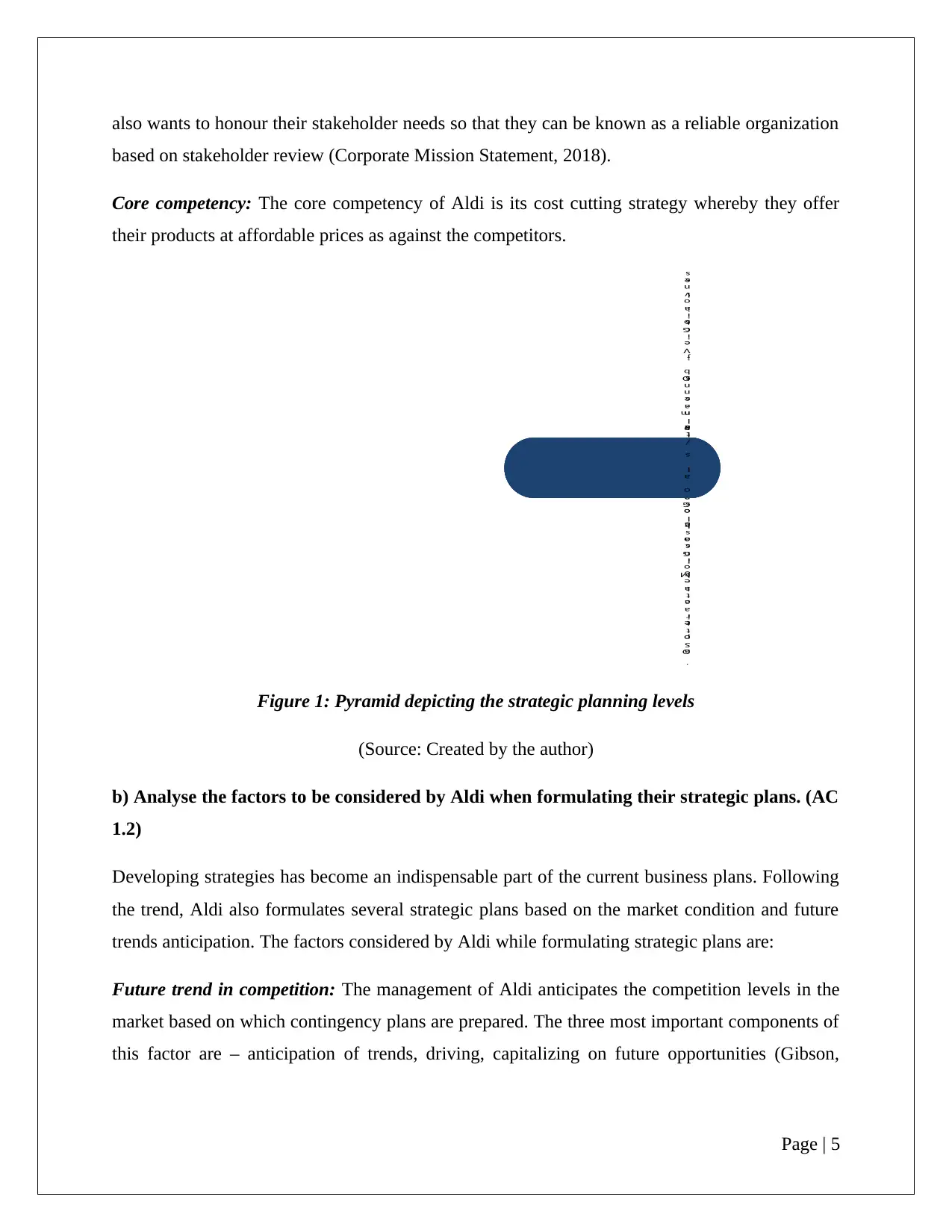
also wants to honour their stakeholder needs so that they can be known as a reliable organization
based on stakeholder review (Corporate Mission Statement, 2018).
Core competency: The core competency of Aldi is its cost cutting strategy whereby they offer
their products at affordable prices as against the competitors.
Figure 1: Pyramid depicting the strategic planning levels
(Source: Created by the author)
b) Analyse the factors to be considered by Aldi when formulating their strategic plans. (AC
1.2)
Developing strategies has become an indispensable part of the current business plans. Following
the trend, Aldi also formulates several strategic plans based on the market condition and future
trends anticipation. The factors considered by Aldi while formulating strategic plans are:
Future trend in competition: The management of Aldi anticipates the competition levels in the
market based on which contingency plans are prepared. The three most important components of
this factor are – anticipation of trends, driving, capitalizing on future opportunities (Gibson,
Page | 5
M
i
s
s
i
o
n
S
t
a
t
e
m
e
n
t
S
t
r
a
t
e
g
i
c
g
o
a
l
s
/
p
l
a
n
s
-
V
i
s
i
o
n
T
a
c
t
i
c
a
l
G
o
a
l
s
/
P
l
a
n
s
-
O
b
j
e
c
t
i
v
e
s
O
p
e
r
a
t
i
o
n
a
l
G
o
a
l
s
/
P
l
a
n
s
-
G
o
a
l
s
based on stakeholder review (Corporate Mission Statement, 2018).
Core competency: The core competency of Aldi is its cost cutting strategy whereby they offer
their products at affordable prices as against the competitors.
Figure 1: Pyramid depicting the strategic planning levels
(Source: Created by the author)
b) Analyse the factors to be considered by Aldi when formulating their strategic plans. (AC
1.2)
Developing strategies has become an indispensable part of the current business plans. Following
the trend, Aldi also formulates several strategic plans based on the market condition and future
trends anticipation. The factors considered by Aldi while formulating strategic plans are:
Future trend in competition: The management of Aldi anticipates the competition levels in the
market based on which contingency plans are prepared. The three most important components of
this factor are – anticipation of trends, driving, capitalizing on future opportunities (Gibson,
Page | 5
M
i
s
s
i
o
n
S
t
a
t
e
m
e
n
t
S
t
r
a
t
e
g
i
c
g
o
a
l
s
/
p
l
a
n
s
-
V
i
s
i
o
n
T
a
c
t
i
c
a
l
G
o
a
l
s
/
P
l
a
n
s
-
O
b
j
e
c
t
i
v
e
s
O
p
e
r
a
t
i
o
n
a
l
G
o
a
l
s
/
P
l
a
n
s
-
G
o
a
l
s
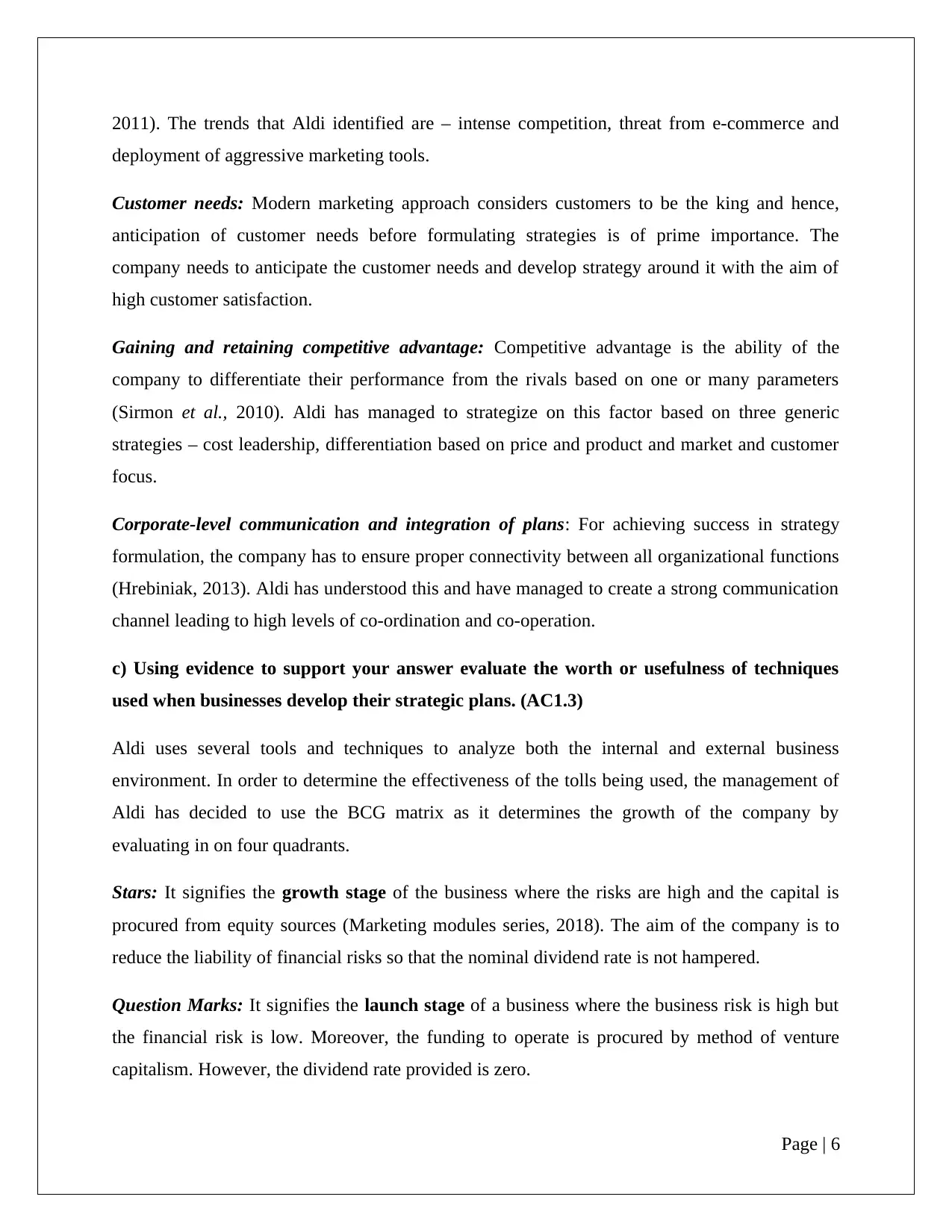
2011). The trends that Aldi identified are – intense competition, threat from e-commerce and
deployment of aggressive marketing tools.
Customer needs: Modern marketing approach considers customers to be the king and hence,
anticipation of customer needs before formulating strategies is of prime importance. The
company needs to anticipate the customer needs and develop strategy around it with the aim of
high customer satisfaction.
Gaining and retaining competitive advantage: Competitive advantage is the ability of the
company to differentiate their performance from the rivals based on one or many parameters
(Sirmon et al., 2010). Aldi has managed to strategize on this factor based on three generic
strategies – cost leadership, differentiation based on price and product and market and customer
focus.
Corporate-level communication and integration of plans: For achieving success in strategy
formulation, the company has to ensure proper connectivity between all organizational functions
(Hrebiniak, 2013). Aldi has understood this and have managed to create a strong communication
channel leading to high levels of co-ordination and co-operation.
c) Using evidence to support your answer evaluate the worth or usefulness of techniques
used when businesses develop their strategic plans. (AC1.3)
Aldi uses several tools and techniques to analyze both the internal and external business
environment. In order to determine the effectiveness of the tolls being used, the management of
Aldi has decided to use the BCG matrix as it determines the growth of the company by
evaluating in on four quadrants.
Stars: It signifies the growth stage of the business where the risks are high and the capital is
procured from equity sources (Marketing modules series, 2018). The aim of the company is to
reduce the liability of financial risks so that the nominal dividend rate is not hampered.
Question Marks: It signifies the launch stage of a business where the business risk is high but
the financial risk is low. Moreover, the funding to operate is procured by method of venture
capitalism. However, the dividend rate provided is zero.
Page | 6
deployment of aggressive marketing tools.
Customer needs: Modern marketing approach considers customers to be the king and hence,
anticipation of customer needs before formulating strategies is of prime importance. The
company needs to anticipate the customer needs and develop strategy around it with the aim of
high customer satisfaction.
Gaining and retaining competitive advantage: Competitive advantage is the ability of the
company to differentiate their performance from the rivals based on one or many parameters
(Sirmon et al., 2010). Aldi has managed to strategize on this factor based on three generic
strategies – cost leadership, differentiation based on price and product and market and customer
focus.
Corporate-level communication and integration of plans: For achieving success in strategy
formulation, the company has to ensure proper connectivity between all organizational functions
(Hrebiniak, 2013). Aldi has understood this and have managed to create a strong communication
channel leading to high levels of co-ordination and co-operation.
c) Using evidence to support your answer evaluate the worth or usefulness of techniques
used when businesses develop their strategic plans. (AC1.3)
Aldi uses several tools and techniques to analyze both the internal and external business
environment. In order to determine the effectiveness of the tolls being used, the management of
Aldi has decided to use the BCG matrix as it determines the growth of the company by
evaluating in on four quadrants.
Stars: It signifies the growth stage of the business where the risks are high and the capital is
procured from equity sources (Marketing modules series, 2018). The aim of the company is to
reduce the liability of financial risks so that the nominal dividend rate is not hampered.
Question Marks: It signifies the launch stage of a business where the business risk is high but
the financial risk is low. Moreover, the funding to operate is procured by method of venture
capitalism. However, the dividend rate provided is zero.
Page | 6
⊘ This is a preview!⊘
Do you want full access?
Subscribe today to unlock all pages.

Trusted by 1+ million students worldwide
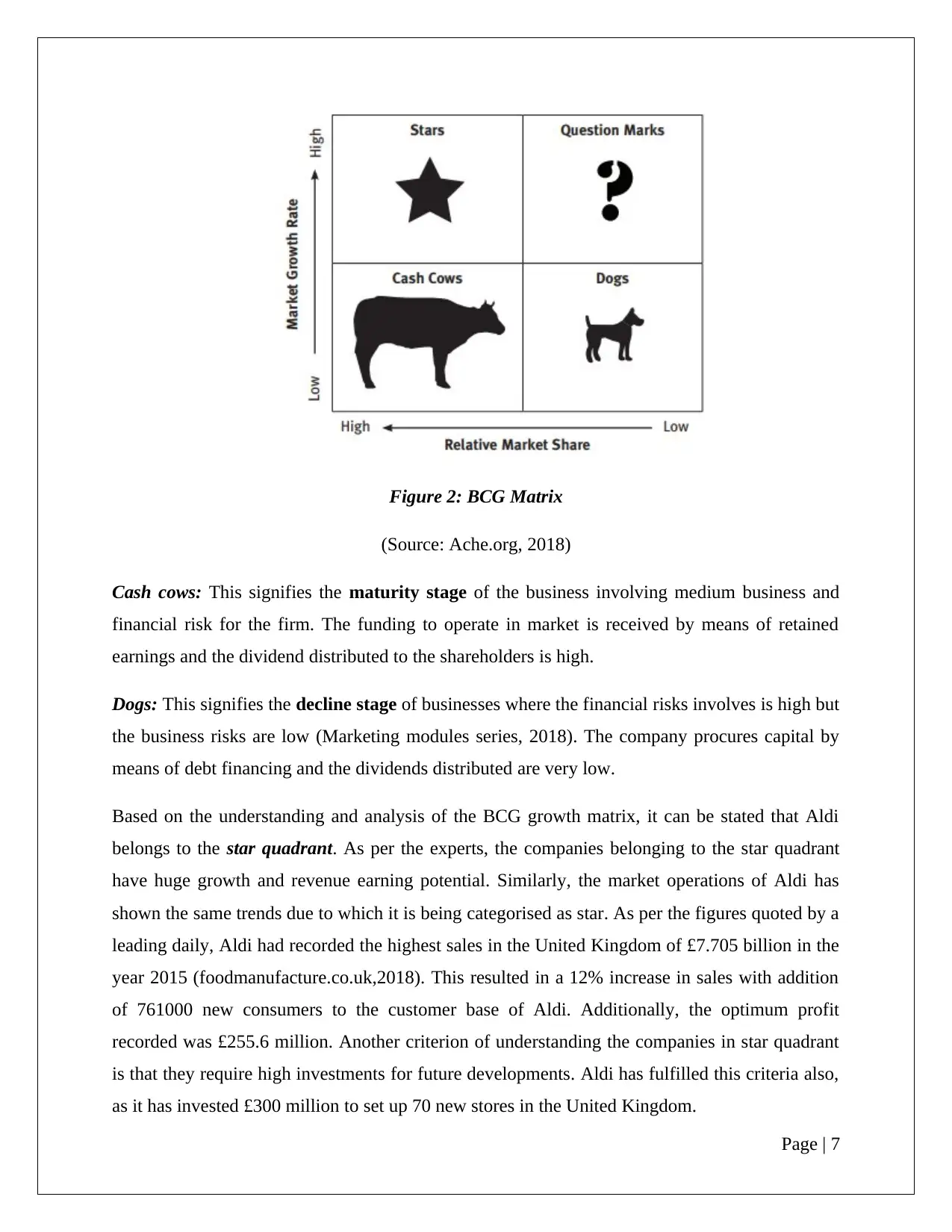
Figure 2: BCG Matrix
(Source: Ache.org, 2018)
Cash cows: This signifies the maturity stage of the business involving medium business and
financial risk for the firm. The funding to operate in market is received by means of retained
earnings and the dividend distributed to the shareholders is high.
Dogs: This signifies the decline stage of businesses where the financial risks involves is high but
the business risks are low (Marketing modules series, 2018). The company procures capital by
means of debt financing and the dividends distributed are very low.
Based on the understanding and analysis of the BCG growth matrix, it can be stated that Aldi
belongs to the star quadrant. As per the experts, the companies belonging to the star quadrant
have huge growth and revenue earning potential. Similarly, the market operations of Aldi has
shown the same trends due to which it is being categorised as star. As per the figures quoted by a
leading daily, Aldi had recorded the highest sales in the United Kingdom of £7.705 billion in the
year 2015 (foodmanufacture.co.uk,2018). This resulted in a 12% increase in sales with addition
of 761000 new consumers to the customer base of Aldi. Additionally, the optimum profit
recorded was £255.6 million. Another criterion of understanding the companies in star quadrant
is that they require high investments for future developments. Aldi has fulfilled this criteria also,
as it has invested £300 million to set up 70 new stores in the United Kingdom.
Page | 7
(Source: Ache.org, 2018)
Cash cows: This signifies the maturity stage of the business involving medium business and
financial risk for the firm. The funding to operate in market is received by means of retained
earnings and the dividend distributed to the shareholders is high.
Dogs: This signifies the decline stage of businesses where the financial risks involves is high but
the business risks are low (Marketing modules series, 2018). The company procures capital by
means of debt financing and the dividends distributed are very low.
Based on the understanding and analysis of the BCG growth matrix, it can be stated that Aldi
belongs to the star quadrant. As per the experts, the companies belonging to the star quadrant
have huge growth and revenue earning potential. Similarly, the market operations of Aldi has
shown the same trends due to which it is being categorised as star. As per the figures quoted by a
leading daily, Aldi had recorded the highest sales in the United Kingdom of £7.705 billion in the
year 2015 (foodmanufacture.co.uk,2018). This resulted in a 12% increase in sales with addition
of 761000 new consumers to the customer base of Aldi. Additionally, the optimum profit
recorded was £255.6 million. Another criterion of understanding the companies in star quadrant
is that they require high investments for future developments. Aldi has fulfilled this criteria also,
as it has invested £300 million to set up 70 new stores in the United Kingdom.
Page | 7
Paraphrase This Document
Need a fresh take? Get an instant paraphrase of this document with our AI Paraphraser
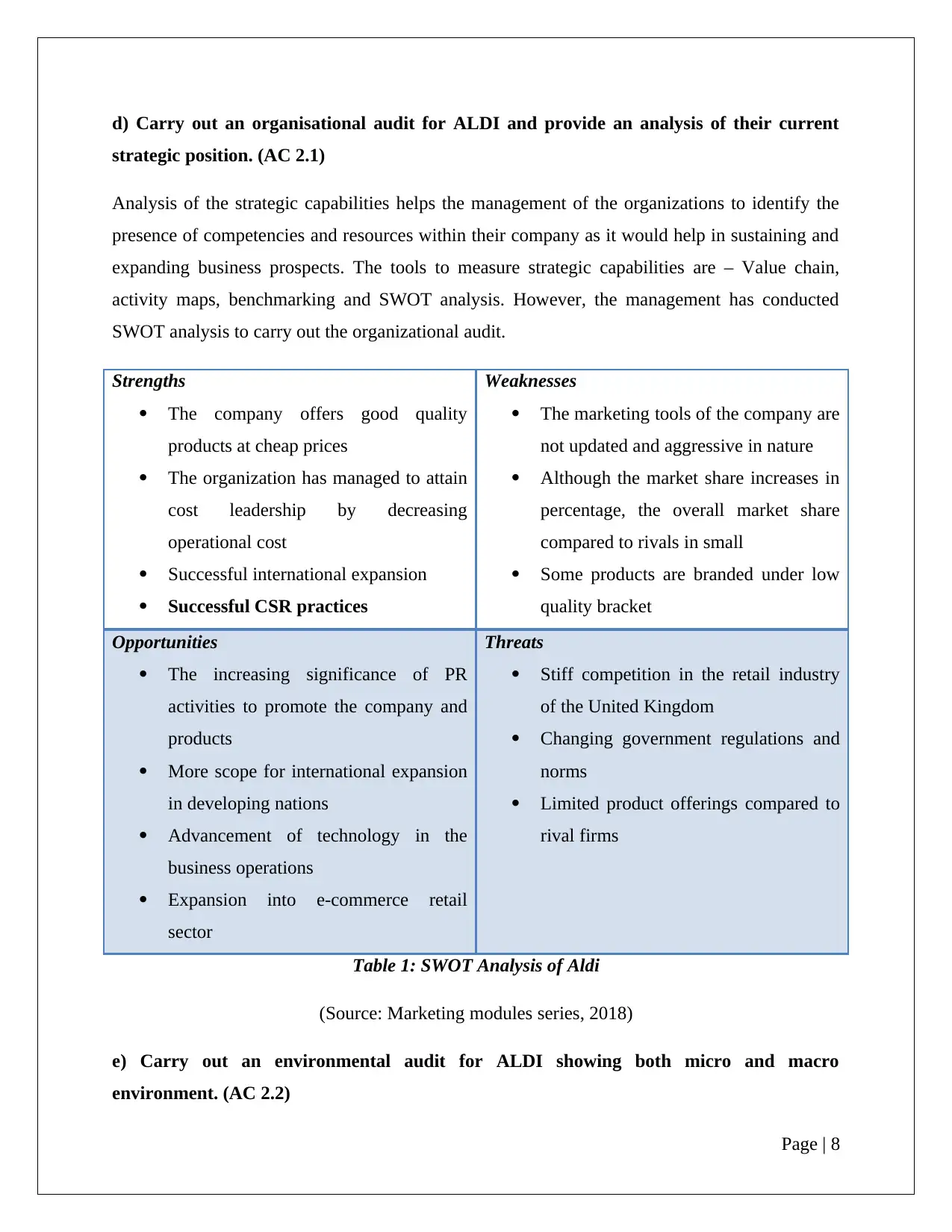
d) Carry out an organisational audit for ALDI and provide an analysis of their current
strategic position. (AC 2.1)
Analysis of the strategic capabilities helps the management of the organizations to identify the
presence of competencies and resources within their company as it would help in sustaining and
expanding business prospects. The tools to measure strategic capabilities are – Value chain,
activity maps, benchmarking and SWOT analysis. However, the management has conducted
SWOT analysis to carry out the organizational audit.
Strengths
The company offers good quality
products at cheap prices
The organization has managed to attain
cost leadership by decreasing
operational cost
Successful international expansion
Successful CSR practices
Weaknesses
The marketing tools of the company are
not updated and aggressive in nature
Although the market share increases in
percentage, the overall market share
compared to rivals in small
Some products are branded under low
quality bracket
Opportunities
The increasing significance of PR
activities to promote the company and
products
More scope for international expansion
in developing nations
Advancement of technology in the
business operations
Expansion into e-commerce retail
sector
Threats
Stiff competition in the retail industry
of the United Kingdom
Changing government regulations and
norms
Limited product offerings compared to
rival firms
Table 1: SWOT Analysis of Aldi
(Source: Marketing modules series, 2018)
e) Carry out an environmental audit for ALDI showing both micro and macro
environment. (AC 2.2)
Page | 8
strategic position. (AC 2.1)
Analysis of the strategic capabilities helps the management of the organizations to identify the
presence of competencies and resources within their company as it would help in sustaining and
expanding business prospects. The tools to measure strategic capabilities are – Value chain,
activity maps, benchmarking and SWOT analysis. However, the management has conducted
SWOT analysis to carry out the organizational audit.
Strengths
The company offers good quality
products at cheap prices
The organization has managed to attain
cost leadership by decreasing
operational cost
Successful international expansion
Successful CSR practices
Weaknesses
The marketing tools of the company are
not updated and aggressive in nature
Although the market share increases in
percentage, the overall market share
compared to rivals in small
Some products are branded under low
quality bracket
Opportunities
The increasing significance of PR
activities to promote the company and
products
More scope for international expansion
in developing nations
Advancement of technology in the
business operations
Expansion into e-commerce retail
sector
Threats
Stiff competition in the retail industry
of the United Kingdom
Changing government regulations and
norms
Limited product offerings compared to
rival firms
Table 1: SWOT Analysis of Aldi
(Source: Marketing modules series, 2018)
e) Carry out an environmental audit for ALDI showing both micro and macro
environment. (AC 2.2)
Page | 8
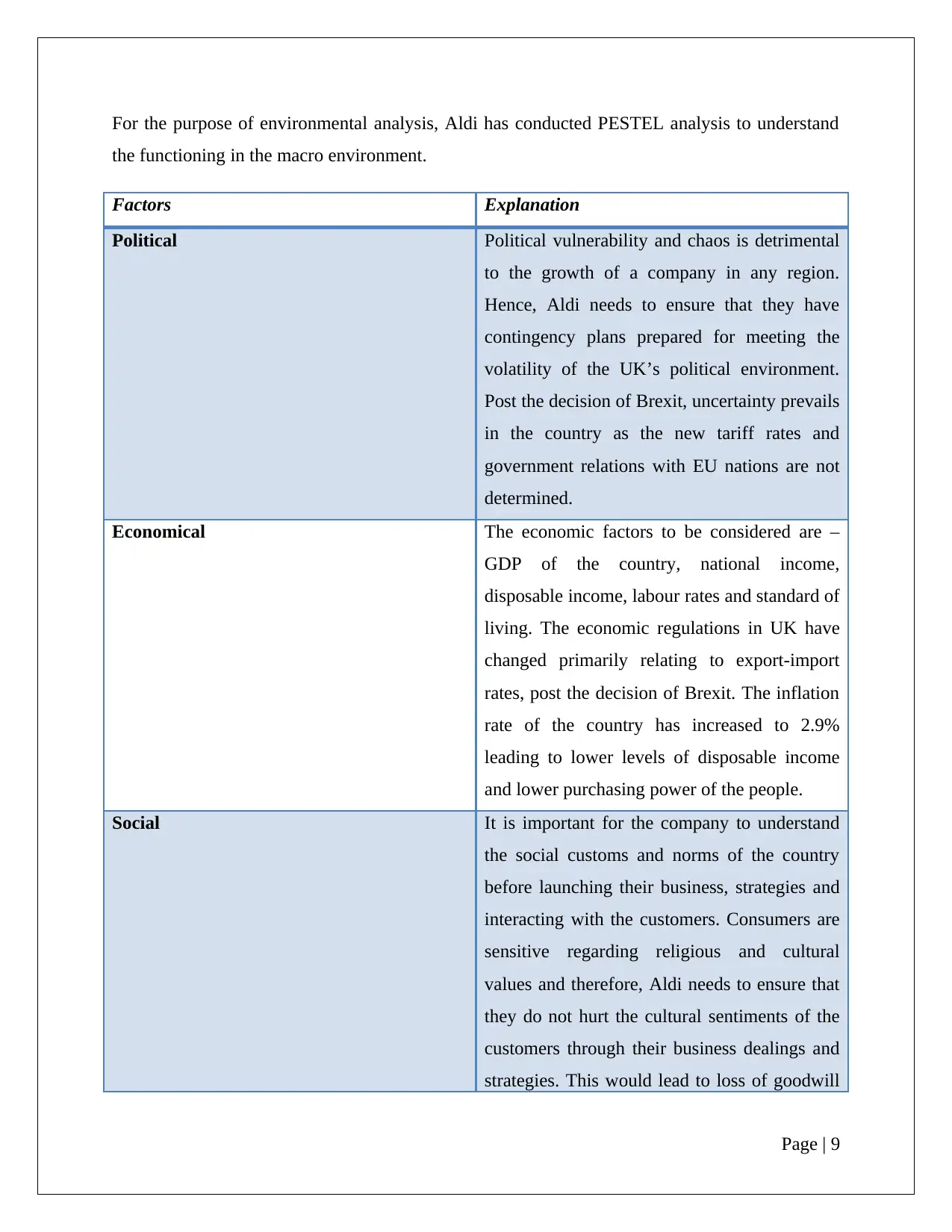
For the purpose of environmental analysis, Aldi has conducted PESTEL analysis to understand
the functioning in the macro environment.
Factors Explanation
Political Political vulnerability and chaos is detrimental
to the growth of a company in any region.
Hence, Aldi needs to ensure that they have
contingency plans prepared for meeting the
volatility of the UK’s political environment.
Post the decision of Brexit, uncertainty prevails
in the country as the new tariff rates and
government relations with EU nations are not
determined.
Economical The economic factors to be considered are –
GDP of the country, national income,
disposable income, labour rates and standard of
living. The economic regulations in UK have
changed primarily relating to export-import
rates, post the decision of Brexit. The inflation
rate of the country has increased to 2.9%
leading to lower levels of disposable income
and lower purchasing power of the people.
Social It is important for the company to understand
the social customs and norms of the country
before launching their business, strategies and
interacting with the customers. Consumers are
sensitive regarding religious and cultural
values and therefore, Aldi needs to ensure that
they do not hurt the cultural sentiments of the
customers through their business dealings and
strategies. This would lead to loss of goodwill
Page | 9
the functioning in the macro environment.
Factors Explanation
Political Political vulnerability and chaos is detrimental
to the growth of a company in any region.
Hence, Aldi needs to ensure that they have
contingency plans prepared for meeting the
volatility of the UK’s political environment.
Post the decision of Brexit, uncertainty prevails
in the country as the new tariff rates and
government relations with EU nations are not
determined.
Economical The economic factors to be considered are –
GDP of the country, national income,
disposable income, labour rates and standard of
living. The economic regulations in UK have
changed primarily relating to export-import
rates, post the decision of Brexit. The inflation
rate of the country has increased to 2.9%
leading to lower levels of disposable income
and lower purchasing power of the people.
Social It is important for the company to understand
the social customs and norms of the country
before launching their business, strategies and
interacting with the customers. Consumers are
sensitive regarding religious and cultural
values and therefore, Aldi needs to ensure that
they do not hurt the cultural sentiments of the
customers through their business dealings and
strategies. This would lead to loss of goodwill
Page | 9
⊘ This is a preview!⊘
Do you want full access?
Subscribe today to unlock all pages.

Trusted by 1+ million students worldwide
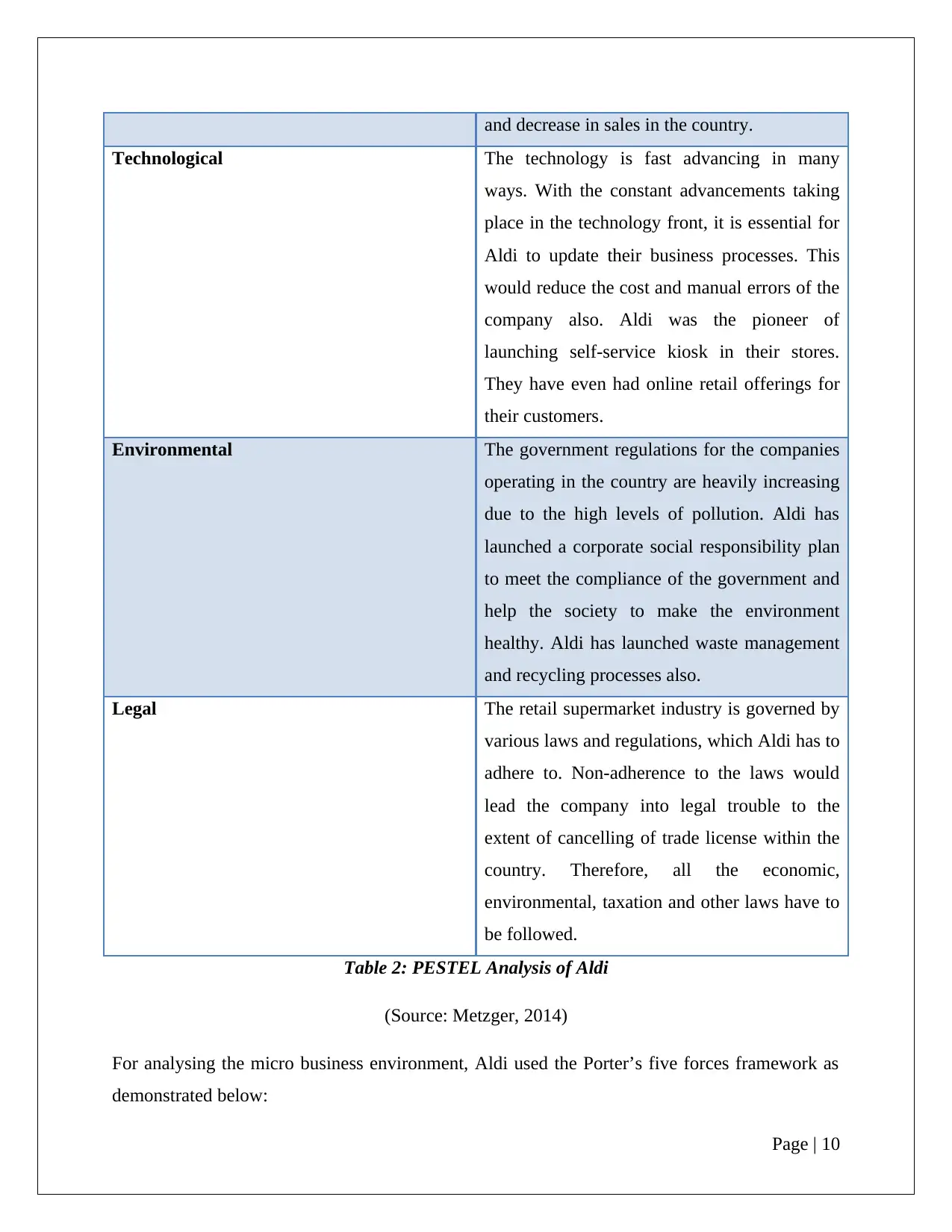
and decrease in sales in the country.
Technological The technology is fast advancing in many
ways. With the constant advancements taking
place in the technology front, it is essential for
Aldi to update their business processes. This
would reduce the cost and manual errors of the
company also. Aldi was the pioneer of
launching self-service kiosk in their stores.
They have even had online retail offerings for
their customers.
Environmental The government regulations for the companies
operating in the country are heavily increasing
due to the high levels of pollution. Aldi has
launched a corporate social responsibility plan
to meet the compliance of the government and
help the society to make the environment
healthy. Aldi has launched waste management
and recycling processes also.
Legal The retail supermarket industry is governed by
various laws and regulations, which Aldi has to
adhere to. Non-adherence to the laws would
lead the company into legal trouble to the
extent of cancelling of trade license within the
country. Therefore, all the economic,
environmental, taxation and other laws have to
be followed.
Table 2: PESTEL Analysis of Aldi
(Source: Metzger, 2014)
For analysing the micro business environment, Aldi used the Porter’s five forces framework as
demonstrated below:
Page | 10
Technological The technology is fast advancing in many
ways. With the constant advancements taking
place in the technology front, it is essential for
Aldi to update their business processes. This
would reduce the cost and manual errors of the
company also. Aldi was the pioneer of
launching self-service kiosk in their stores.
They have even had online retail offerings for
their customers.
Environmental The government regulations for the companies
operating in the country are heavily increasing
due to the high levels of pollution. Aldi has
launched a corporate social responsibility plan
to meet the compliance of the government and
help the society to make the environment
healthy. Aldi has launched waste management
and recycling processes also.
Legal The retail supermarket industry is governed by
various laws and regulations, which Aldi has to
adhere to. Non-adherence to the laws would
lead the company into legal trouble to the
extent of cancelling of trade license within the
country. Therefore, all the economic,
environmental, taxation and other laws have to
be followed.
Table 2: PESTEL Analysis of Aldi
(Source: Metzger, 2014)
For analysing the micro business environment, Aldi used the Porter’s five forces framework as
demonstrated below:
Page | 10
Paraphrase This Document
Need a fresh take? Get an instant paraphrase of this document with our AI Paraphraser
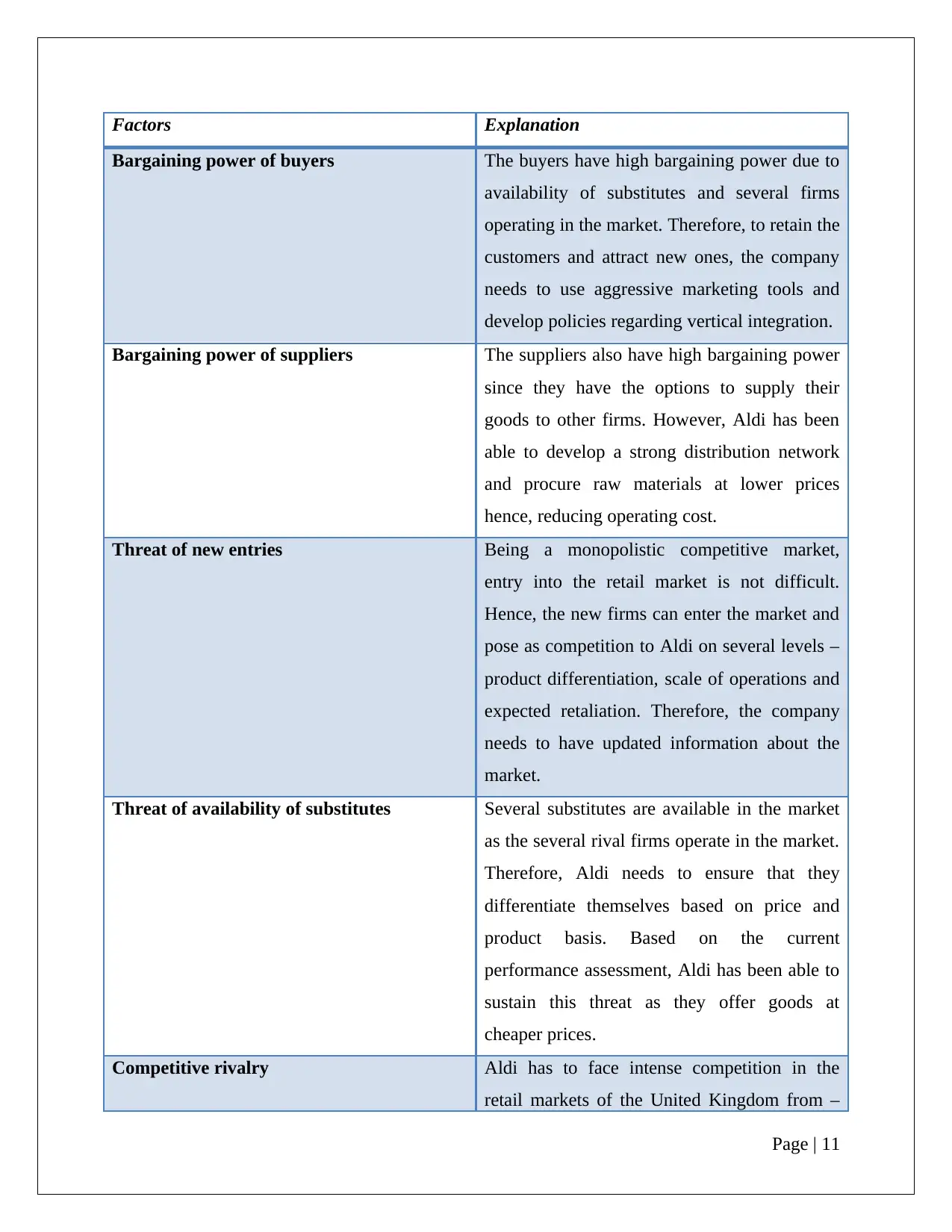
Factors Explanation
Bargaining power of buyers The buyers have high bargaining power due to
availability of substitutes and several firms
operating in the market. Therefore, to retain the
customers and attract new ones, the company
needs to use aggressive marketing tools and
develop policies regarding vertical integration.
Bargaining power of suppliers The suppliers also have high bargaining power
since they have the options to supply their
goods to other firms. However, Aldi has been
able to develop a strong distribution network
and procure raw materials at lower prices
hence, reducing operating cost.
Threat of new entries Being a monopolistic competitive market,
entry into the retail market is not difficult.
Hence, the new firms can enter the market and
pose as competition to Aldi on several levels –
product differentiation, scale of operations and
expected retaliation. Therefore, the company
needs to have updated information about the
market.
Threat of availability of substitutes Several substitutes are available in the market
as the several rival firms operate in the market.
Therefore, Aldi needs to ensure that they
differentiate themselves based on price and
product basis. Based on the current
performance assessment, Aldi has been able to
sustain this threat as they offer goods at
cheaper prices.
Competitive rivalry Aldi has to face intense competition in the
retail markets of the United Kingdom from –
Page | 11
Bargaining power of buyers The buyers have high bargaining power due to
availability of substitutes and several firms
operating in the market. Therefore, to retain the
customers and attract new ones, the company
needs to use aggressive marketing tools and
develop policies regarding vertical integration.
Bargaining power of suppliers The suppliers also have high bargaining power
since they have the options to supply their
goods to other firms. However, Aldi has been
able to develop a strong distribution network
and procure raw materials at lower prices
hence, reducing operating cost.
Threat of new entries Being a monopolistic competitive market,
entry into the retail market is not difficult.
Hence, the new firms can enter the market and
pose as competition to Aldi on several levels –
product differentiation, scale of operations and
expected retaliation. Therefore, the company
needs to have updated information about the
market.
Threat of availability of substitutes Several substitutes are available in the market
as the several rival firms operate in the market.
Therefore, Aldi needs to ensure that they
differentiate themselves based on price and
product basis. Based on the current
performance assessment, Aldi has been able to
sustain this threat as they offer goods at
cheaper prices.
Competitive rivalry Aldi has to face intense competition in the
retail markets of the United Kingdom from –
Page | 11
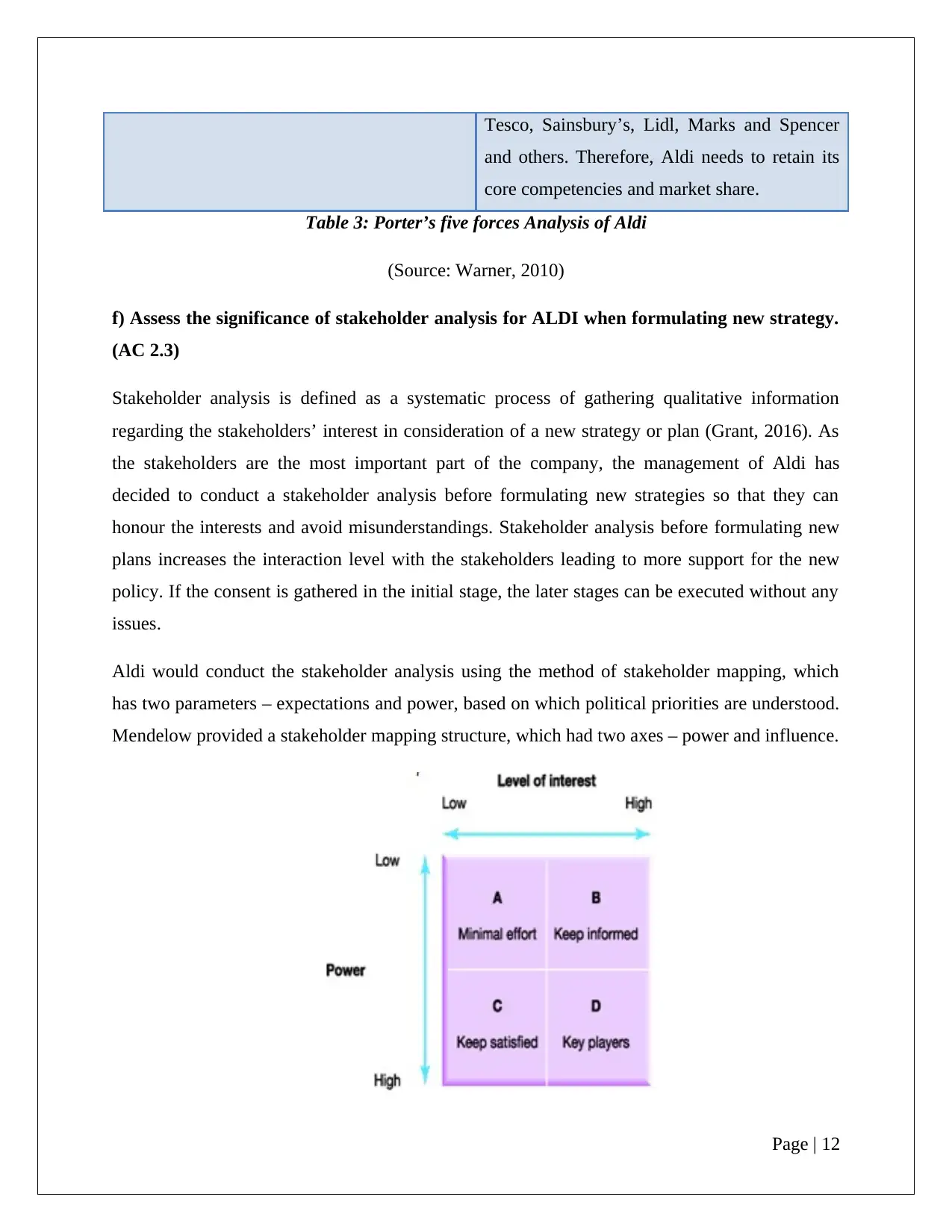
Tesco, Sainsbury’s, Lidl, Marks and Spencer
and others. Therefore, Aldi needs to retain its
core competencies and market share.
Table 3: Porter’s five forces Analysis of Aldi
(Source: Warner, 2010)
f) Assess the significance of stakeholder analysis for ALDI when formulating new strategy.
(AC 2.3)
Stakeholder analysis is defined as a systematic process of gathering qualitative information
regarding the stakeholders’ interest in consideration of a new strategy or plan (Grant, 2016). As
the stakeholders are the most important part of the company, the management of Aldi has
decided to conduct a stakeholder analysis before formulating new strategies so that they can
honour the interests and avoid misunderstandings. Stakeholder analysis before formulating new
plans increases the interaction level with the stakeholders leading to more support for the new
policy. If the consent is gathered in the initial stage, the later stages can be executed without any
issues.
Aldi would conduct the stakeholder analysis using the method of stakeholder mapping, which
has two parameters – expectations and power, based on which political priorities are understood.
Mendelow provided a stakeholder mapping structure, which had two axes – power and influence.
Page | 12
and others. Therefore, Aldi needs to retain its
core competencies and market share.
Table 3: Porter’s five forces Analysis of Aldi
(Source: Warner, 2010)
f) Assess the significance of stakeholder analysis for ALDI when formulating new strategy.
(AC 2.3)
Stakeholder analysis is defined as a systematic process of gathering qualitative information
regarding the stakeholders’ interest in consideration of a new strategy or plan (Grant, 2016). As
the stakeholders are the most important part of the company, the management of Aldi has
decided to conduct a stakeholder analysis before formulating new strategies so that they can
honour the interests and avoid misunderstandings. Stakeholder analysis before formulating new
plans increases the interaction level with the stakeholders leading to more support for the new
policy. If the consent is gathered in the initial stage, the later stages can be executed without any
issues.
Aldi would conduct the stakeholder analysis using the method of stakeholder mapping, which
has two parameters – expectations and power, based on which political priorities are understood.
Mendelow provided a stakeholder mapping structure, which had two axes – power and influence.
Page | 12
⊘ This is a preview!⊘
Do you want full access?
Subscribe today to unlock all pages.

Trusted by 1+ million students worldwide
1 out of 24
Related Documents
Your All-in-One AI-Powered Toolkit for Academic Success.
+13062052269
info@desklib.com
Available 24*7 on WhatsApp / Email
![[object Object]](/_next/static/media/star-bottom.7253800d.svg)
Unlock your academic potential
Copyright © 2020–2025 A2Z Services. All Rights Reserved. Developed and managed by ZUCOL.





